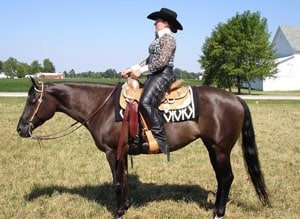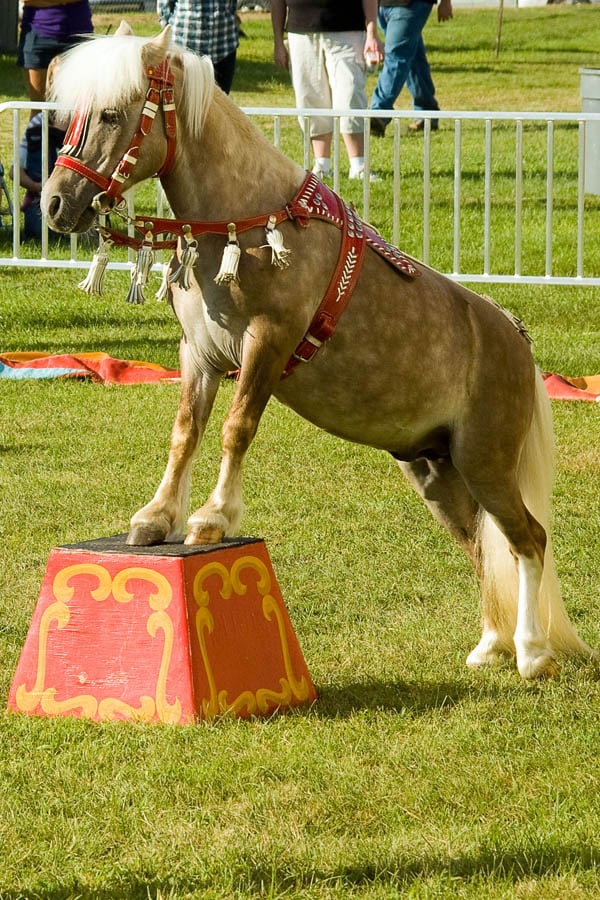
Most people in the horse world have at least heard of barrel racing: a somewhat controversial rodeo event that consists of a three-leaf clover pattern around three barrels and the fastest time wins.
Barrel racing is often oversimplified. Critics of the sport often tout it as cruel and requiring no skill, just a bunch of whipping and spurring. Supporters of the support defend it as requiring far more skill than one might think, but too often fail to expound upon the intricacies of their sport. The matter is further complicated by the legions of well-meaning, but poorly trained, backyard barrel racers who give the sport a bad rap.
The secret to barrel racing isn’t being able to run a three-leaf clover. In fact, a barrel horse that is trained properly already knows how to run a barrel pattern before he’s ever even seen a barrel pattern. I know, it sounds like another oxymoron. Bear with me. A good barrel racer must break the pattern down into its component parts and let the horse master each little maneuver individually before putting them back together to form a finished pattern. Once the horse knows each of the component parts, putting them together into a pattern is an easy last step!
We’re actually going to discuss training for both the horse and the rider, but I’m going to start with rider.
What makes a good barrel racer (rider)?
1. Quiet hands
This is a huge issue for many barrel racers, myself included some days. We get caught up in the heat of the run and we get handsy and all up in our horse’s face trying to “help.” Well, guess what? You’re not helping! Loud hands just get in the horse’s way. A barrel horse that is properly trained knows his job and should only need subtle cues as a reminder. Jerking on the horse’s face throws the horse off balance, creates a national outrage and gets PETA all up in everyone’s business. Don’t do it.
2. Independent seat
Many people don’t fully understand what is meant by “an independent seat.” Having an independent seat means that you have enough strength to cue with different parts of your body without affecting the rest. For example, shifting your weight to the right while still being able to cue effectively with your left leg without your left leg slipping out of position or losing your stirrup.
The lack of an independent seat often leads to the need for rubber bands to hold the rider’s feet into stirrups. Now, I know supporters of the banding practice will probably argue that a rider can have an independent seat and still need bands due to the sheer speed at which the pattern is run. However, if you truly have an independent seat, losing a stirrup in the middle of the pattern is not a catastrophe. A rider with an independent seat has the core strength to recover and move on, but I digress.
3. Quiet legs
Loud, flapping legs are also known to the meme community as starfishing and rightfully so as they just make barrel racers look ridiculous. If you can fit a basketball between your butt and the saddle…no, just don’t.

You’re destroying your horse’s back and actually slowing them down. How about this. Have someone stand behind you while you try to take some really deep breaths, then have them jab you in the sides with their thumbs really hard. Hurt much? Yeah, that’s what the horse feels while its running with a starfish rider. Then add the pounding the back takes from the butt hitting the saddle and sharp spurs for some poor souls.
Starfishers might look like they’re “riding hard” to some people, but they’re just slowing themselves down. Quiet legs and a quiet, independent seat is the way to go. If you want to encourage the horse, squeezing with your thighs or maybe a tap from a whip will do. Lots of vocalization is ok if it helps your horse.

4. Pick a bit that is right for you and your horse, not because it’s the latest fad with your barrel racing hero’s name stamped on it
A lot of well-trained barrel horse could run in snaffles if their riders took the time to ride them properly. That being said, there is no one size fits all approach and sometimes there is a genuine need for say a lifter bit or a correction bit of some kind. However, caution should be used. Don’t fix what isn’t broke. Don’t go slapping a lifter or correction on just because you’re embarrassed to run in a snaffle or because that’s what everyone else is using. You may end up creating a problem that wasn’t there to begin with. Give your horse a solid foundation first, then look for weakness in his performance over time and decide if he really needs something other than a snaffle. If he doesn’t, then congratulate yourself on a job well done. If in doubt, consult a trusted equine professional or refer to our Bits 101 series to learn more about the different types of bits available.
What makes a good barrel horse?
1. Yielding the forequarters
You need to have full control of every part of a barrel horse’s body. This includes yielding the forequarters. Yielding the forequarters is important for teaching shoulder control. This allows you to give corrections when you feel the horse’s inside shoulder start to drop coming into a turn. Dropping the shoulder in the turn in the number one cause of knocking a barrel in barrel racing. Depending on the rules of the race you are running in, knocking a barrel can get you either a 3 second or 5 second penalty. Some races will disqualify you outright.
2. Yielding the hindquarters
Yielding the hindquarters is important due to hip control. The horse’s hindquarters are his engine. Having his hindquarters fully engaged under him through a turn is like turning on the 4-wheel-drive in your car. But, if the horse’s hip swings out too far in the turn, his loses a lot of momentum and balance, slowing him down coming out of the turn and sabotaging his momentum going into the next turn. If his hindquarters remain engaged, he builds momentum coming out of every turn so he gradually builds speed through the pattern. But, if your horse lacks that vital hip control, he loses momentum and speed through the pattern as each turn becomes much harder, tiring him quicker and slowing him significantly.
3. Bend through the ribcage

You’ve got control of the front end and the back end, but you can’t forget about the middle. It is important that you are able to control the amount of bend through your horse’s ribcage throughout the pattern. Obviously, between the barrels your horse should be running straight with no bend, but through the turns it gets a little trickier. If you don’t have enough bend, you will end up doing a rollback around the barrel. While this may look cool, it usually doesn’t win because it slows you down and drains momentum due to the massive amount of effort it takes to rollback at the speed. It’s also dangerous because it’s very easy to rollback on top of the barrel and incur hefty penalties for knocked barrels. If you have too much bend though, your horse loses traction completely falls apart through the turn as he tries to wrap too far around the barrel, again greatly increasing the chances on knocking the barrel and slowing you down as he cannot get his hindquarters (his engine) under him properly. You want just enough bend to slingshot around the barrel and continue gaining momentum. Exercises such as leg yields, side passing, and circles help with controlling bend.
4. Rate
Ah, perhaps the most well-known barrel racing term that gets tossed around and abused daily. Essentially, rate is another fancy term for collection. You need to be able to slow down – or rate – your horse within each gate while coming into a turn so you can collect and prepare to make the turn safely and efficiency. Rate requires collection and without rate, you will not win a barrel race.
This is one of the big reasons I recommend dressage cross training for barrel racing and why I got into dressage myself. A “ratey” is a collected horse and collection beats raw speed every time. Collection also gives you the fine-tuned body control to fulfill all the other requirements and more on this list.
5. Poll flexion
A barrel horse must be soft in the face. A hard-mouthed barrel horse that roots against the bit is a danger to himself, his rider, and everyone around him. Way too many barrel horse have zero flexion at the poll. A horse that is that stiff has no business in the barrel pen.
A barrel horse can hit speeds of 30 mph or more at various points throughout the pattern. That doesn’t leave a lot of reaction time for course correction. So, if you’re coming into a barrel and you feel that shoulder start to drop or the nose tip out or that hip start to swing out of position through the turn, you need an emergency course correction and that horse needs to respond now. Not 5 seconds from now, not 2 seconds from now, but the instant you cue. Depending on the size of the pattern the whole run is done in under 14 seconds. Think about that. 14 seconds. A horse taking 5 seconds to respond doesn’t sound that bad to most riders, but when you’re in a 14 second race giving a course correction and your horse takes 5 seconds to respond, you’ve already either blown passed the barrel, run the barrel over or wiped out and are being carted out of the arena on a stretcher.

This is a sport that is won and lost by thousandths of a second. There is no margin for error and no room for second chances.
This is not a game. The adrenaline rush is like nothing else and I wouldn’t trade it for the world. It is fun, exhilarating, and addicting. Racing upwards of 30 mph on a 1000lb beast with a mind of its own around 3 hairpin turns is not to be taken lightly. Both horses and riders are highly trained athletes. One slip, one swerve, one tiny mistake and that 1000lb animal could come crash down on his rider with the force that would shatter the human body. No helmet would save you (but please wear one anyway), no safety vest in the world could protect you. Only training and understanding the seriousness of the situation.
I don’t want to discourage young girls from the sport or drive people away, but I do want them to realize that this is not the pleasure arena. The danger of any equine event is real, but events that involve this kind of speed and precision are even more so and “just running it for fun” should still be taken seriously.
Photo by Moosealope










Barrel racing is hard and your content is annoying
A lot of people use rubber bands to keep their foot and stirrups together when the have to lift a leg by a barrel